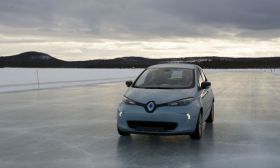20
AUG
2013
Renault-Nissan Alliance Team
.
.
Renault ZOE: cold weather tests

Vehicle powertrains and mechanical components are subjected to tough conditions in winter. So we have to make sure that the cars we put on the road can resist extreme temperatures. Other components apart from the engine are closely monitored. The gearbox, for example, must not be restricted or slowed down by extreme cold.
We check a broad range of equipment, including the heating, and pay close attention to the quality of defogging and defrosting systems and the correct operation of shock absorbers and the ABS in snow. We also ensure that no snow gets under the hood or builds up on the brakes, which could lead to problems. The only way to properly check these points is through cold weather test drives. Which is why they are so important.
In short, the aim of cold weather tests is to detect any operating problems and solve them. By simulating winter conditions, the tests allow us to validate technological choices that guarantee consistent vehicle behavior and comfort in the most extreme conditions.
Electric vehicle particularities
As you probably know, an electric vehicle doesn’t react the same way to cold as an internal-combustion vehicle. Renault ZOE doesn’t use oil or gas, so our engineers don’t have to monitor these items. But other Renault ZOE components required particular attention during cold weather testing.
First of all, we had to examine how cold weather conditions affect the battery, notably in terms of capacity, power and charge. We also had to check the charging system.
Our first conclusions on Renault ZOE’s results: At -25°C, Renault ZOE is fully functional and drops in performance are almost unnoticeable. The battery performs very well in cold conditions from this point of view.
More noticeable in cold conditions is reduced range, but Renault ZOE remains one of the best mass-produced electric vehicles in this respect, thanks in particular to its reversible heat pump, which reduces heating consumption in cold weather and generates approximately 2kW of cooling or 3kW of heat with just 1kW of electricity.
Renault ZOE scores top marks!
Renault ZOE performs strongly, especially compared with internal-combustion cars, on the following points:
- motor start-up: exactly the same at -30°C as in temperate weather, i.e. immediately and silently. No engine warm-up, no smoke plumes, no clatter.
- first runs: the motor is not affected by the cold. Motorists can drive off straight away and floor the accelerator without having to warm the car up. Also, while in motion, the battery heats up and gradually improves the points mentioned above.
- heating: on top of being frugal, the heat pump provides heat fast. The car doesn’t need to be started several minutes beforehand.
- pre-conditioning system: to heat the cabin up a little and defrost the windows before taking off, drivers simply pre-program the heating and the car is at “room temperature” when they get in. This will never be possible with a combustion vehicle, where the engine needs to be turned on.
Our engineers were pleasantly surprised by Renault ZOE – by the fast-action heat pump, by the strong performance of the battery on power in cold conditions and its ability to start the motor at very low temperatures, and by the car’s road holding, especially grip on slippery surfaces. The battery’s central and low position is a big advantage here.





Post new comment